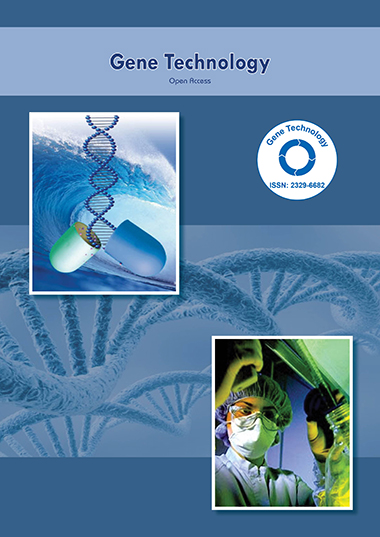Indexed In
- Academic Keys
- ResearchBible
- CiteFactor
- Access to Global Online Research in Agriculture (AGORA)
- RefSeek
- Hamdard University
- EBSCO A-Z
- OCLC- WorldCat
- Publons
- Euro Pub
- Google Scholar
Useful Links
Share This Page
Journal Flyer

Open Access Journals
- Agri and Aquaculture
- Biochemistry
- Bioinformatics & Systems Biology
- Business & Management
- Chemistry
- Clinical Sciences
- Engineering
- Food & Nutrition
- General Science
- Genetics & Molecular Biology
- Immunology & Microbiology
- Medical Sciences
- Neuroscience & Psychology
- Nursing & Health Care
- Pharmaceutical Sciences
Editor Note - (2020) Volume 9, Issue 1
Genes and Identity
Shunyuan Xiao*Received: 31-Mar-2020 Published: 21-Apr-2020, DOI: 10.35248/2329-6682.9.e117
Editorial Note
I am glad to acknowledge that in the year 2019, Gene Technology has published its 8th Volume. More than 30 well professionals in globally acting as an editorial board member of our journal. Gene Technology journal is having Journal impact factor is 0.83*. Papers which are submitted to this journal will undergo rapid peer review process and accept the manuscripts within 21-30 days with Editors decision.
Gene technology (also known as genetic engineering or genetic modification) provides means of making gene modifications–the collection of instructions in all living creatures' cells. Gene technology is defined as the concept that encompasses a variety of activities related to the understanding of gene expression, the benefits of natural genetic variation, gene modification and gene transfer to new hosts.
The authors from different parts of the world addressed the present Volume 8 in various aspects of gene technology. Since decades traditional biotechnology has been practiced. We also used traditional breeding to develop new crops, new livestock breeds and pets. We harnessed yeast for beer and bread, and rennet for cheese. Gene technology is a modern biotechnology branch that makes it possible to directly alter or delete a gene or shift a gene from one species to another. If plants, livestock, and other species modify through gene technology they are known as GMOs. When the alteration includes the addition of a gene from another organism, this is considered transgenic. For example, GM cotton often contains a bacterial gene which produces an insecticide, reducing the need to spray crops to control insect pests.
Aslam et al. [1] studied that expression of certain genes is documented to be enhanced by varying sequence between initiation codon and pET vector up to 1000-fold. It showed that the distance between RBS and start codon as well as the nucleotide sequence is very critical for expression. Changing 3 nucleotides between RBS and starting codon reduces the expression. By altering the sequence of N-terminals of human proinsulin gene.
Farooq et al. [2] analysed Azurin gene is successfully cloned in BL21 codon plus cells using specific growth conditions and time of induction; more details can be obtained on the expression of azurine in BL21 codon plus cells. It is possible to do further studies using specific expression of azurine in E. Different strains of P. aeruginosa were grown at CuSO4 and KNO3 under anaerobic conditions for enhanced azurine synthesis and purified by gel filtration and chromatography of ion exchange.
Aflatooni et al. [3] concluded that the first harvest is appropriate for the preparation of pharmaceutical and industrial essential oils. But it is more suitable for use with spices and feeds in second harvest due to increased plant volume (stems, leaves). It is therefore recommended that conditions such as high temperature, a longer day, adequate irrigation and ample fertilizer (such as n, p, k) should be given to achieve the higher essential oil.
On behalf Gene Technology we would like to acknowledge our journal readers and supporters who make the year big success, we will be providing the same features which have implemented in 2019 and hope the same support for the journal upcoming volume.
REFERENCES
- Aslam F, Farooq A, Qaiser H, Iftikhar S, Saleem F, et al. Molecular detection and expression of azurin: An anti-cancer protein from local isolates of pseudomonas species. Gene Technol. 2019; 8(1): 1-5.
- Aslam F, Latif K, Waseem R, Naz S, Iftikhar S. Recombinant human proinsulin expression in E. coli by Altering 5ʹ untranslated and translated region. Gene Technol . 2019;8(1):1-6.
- Aflatooni H, Ebrahimi M, Hossein R, Akbar G.Evaluation of some morphological characteristics of different basil masses (Ocimum basilicum L.). Gene Technol. 2019;8(2):1-5.
Citation: Xiao S (2020) Genes and Identity. Gene Technology. 9: e117. DOI: 10.35248/2329-6682.9.e117
Copyright: © 2020 Xiao S. This is an open-access article distributed under the terms of the Creative Commons Attribution License, which permits unrestricted use, distribution, and reproduction in any medium, provided the original author and source are credited.

